

Untitled. Untitled. Untitled. The health damage inflicted on people by long-standing air pollution in cities is likely to increase the death rate from coronavirus infections, experts have said.
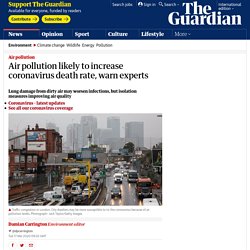
Dirty air is known to cause lung and heart damage and is responsible for at least 8m early deaths a year. This underlying health damage means respiratory infections, such as coronavirus, may well have a more serious impact on city dwellers and those exposed to toxic fumes, than on others. However, strict confinement measures in China, where the coronavirus outbreak began, and in Italy, Europe’s most affected nation, have led to falls in air pollution as fewer vehicles are driven and industrial emissions fall. A preliminary calculation by a US expert suggests that tens of thousands of premature deaths from air pollution may have been avoided by the cleaner air in China, far higher than the 3,208 coronavirus deaths.
Australia's Bushfires Completely Blasted Through the Models. Australia Wildfires Caused 'Unprecedented' Damage to Forests. More than 20% of Australia's forests were scorched, according to a new study.In all, more than 40,000 square miles of land have burned.The fires were fueled by drought, record heat and high winds.
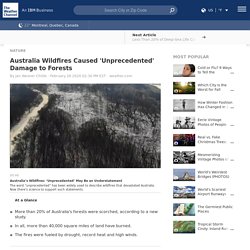
Australia's forests took an extraordinary hit from wildfires that scorched vast swaths of the country in recent months. “This is a globally unprecedented scale of burning, not observed in any other forest biome over the last 20 years," Matthias Boer, lead author of the study and lead scientist of the NSW Bushfire Risk Management Research Hub node at the university, said in a press release. (MORE: Climate Change Poses 'Catastrophic' Threat to National Security, Report Says) Boer said that number is four times higher than the average lost to wildfires in a typical year. Untitled. As disastrous bushfires continue to grip much of the country, causing loss of lives and homes, claims persist that not enough has been done to manage bushland to mitigate fire risk.

One frequent claim is that the “locking up” of national parks has somehow contributed to the increased bushfire risk this season, rather than prolonged dry and hot weather and the influence of climate change. The New South Wales deputy premier, John Barilaro, used this language in November, arguing that the fires showed the “locking up” of bushland and “green-left ideology” had failed. In the Australian newspaper this week, the climate change denier Maurice Newman wrote that entries to parks were commonly “blocked by boulders or chains and padlocks” and fire trails were “so overgrown that a sign identifying them is all that distinguishes them from the rest of the forest”. What does ‘locked up’ mean? In some parks, there are seasonal closures to ensure roads don’t become eroded and damaged during the winter.
Untitled. New photos showing the devastating impact of bushfire in east Gippsland forests are sparking renewed calls for the Victorian government to rethink its approach to logging and bring forward the promised 2030 phase-out of the native timber industry.
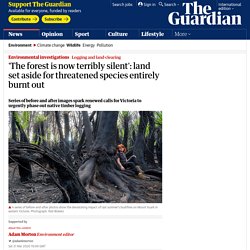
A series of before-and-after pictures by the photographer Rob Blakers show the impact of last summer’s fires on the slopes of Mount Kuark, known as one of the few places in Australia where cool and warm temperate rainforests grow together. All shots were taken within a 48,500-hectare area that the premier, Daniel Andrews, announced in November would be immediately exempt from logging to protect the greater glider and other threatened species. The Goongerah Environment Centre, a local conservation group, said all of Mount Kuark and more than 90% of the newly protected area in Gippsland had been razed. “We didn’t see a single one that had survived,” Blakers said. Untitled. Smoke pollution that blanketed Australia’s south-east for many months during the bushfire crisis may have killed more than 400 people, according to the first published estimate of the scale of health impacts – more than 10 times the number killed by the fires themselves.
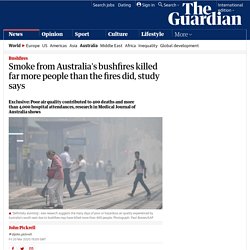
The figures, published in the Medical Journal of Australia, are “definitely alarming”, according to Chris Migliaccio, who studies the long-term effects of wildfire smoke at the University of Montana in Missoula and was not involved in the research. Lead author Fay Johnston, an epidemiologist at the University of Tasmania in Hobart, estimates 80% of Australia’s population of about 25 million was blanketed by smoke this summer. “The fires were unprecedented in Australia’s history, in terms of vast amounts of smoke, the huge populations affected by the smoke and the long duration,” she said.
Burn-offs and logging in old growth can intensify fires, new research shows - Breakfast - ABC Radio. Retired senior NSW Fire Brigade officer Ken Thompson says Australia 'must face reality' on climate action. News, local-news, A SENIOR career firefighter has accused Australian politicians of "wilful ignorance" on climate change because of timid politics and the "corruption of our entire political system" by mining industry funding and influence.
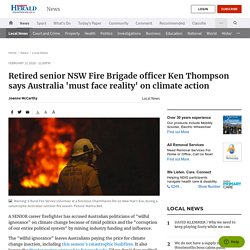
The "wilful ignorance" leaves Australians paying the price for climate change inaction, including this season's catastrophic bushfires. It also leaves the Hunter region exposed to future shocks "if we don't face reality", said Ken Thompson, a former NSW Fire Brigade deputy commissioner and co-founder of the group, Emergency Leaders for Climate Action, made up of 23 former Australian fire response chiefs.
Mr Thompson slammed the Federal Government and Prime Minister Scott Morrison for "throwing climate change words around like word salad". "I listen to Scott Morrison speak on climate change and I think, what the hell is he talking about? "I listen to Scott Morrison speak on climate change and I think, what the hell is he talking about? The burn legacy: why the science on hazard reduction is contested. When it comes to reducing the extent of bushfires, scientists disagree on the best way to do it.
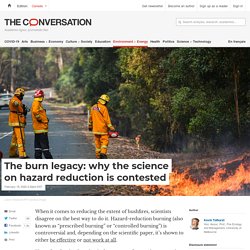
Hazard-reduction burning (also known as “prescribed burning” or “controlled burning”) is controversial and, depending on the scientific paper, it’s shown to either be effective or not work at all. Hazard-reduction burning is the process of removing vegetation that would fuel a fire – the “hazard” – through burning, slashing or grazing. It’s one of the ways state governments try to prepare for looming bushfire seasons. Read more: There's no evidence 'greenies' block bushfire hazard reduction but here's a controlled burn idea worth trying The Climate Council published a fact sheet in January this year titled “Setting the record straight on hazard reduction”.
But this is at odds with empirical studies in Victoria and Western Australia, which found otherwise, after taking a wider view on the issue. Untitled. It was only last week that the massive wildfires that, in January, began tearing through the national park near Australia’s capital city of Canberra were finally declared out.
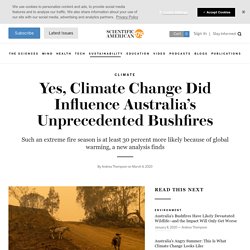
In the intervening weeks they consumed more than 80 percent of the park. This is just one example of the enormous toll taken recently by southeastern Australia’s unprecedented bushfires, which collectively killed more than 30 people, destroyed nearly 6,000 structures and wiped out hundreds of millions of animals. The flames were fanned by a rare perfect storm of conditions, including strong winds, prolonged drought and scorching temperatures—along with a boost from climate change. Global warming has pushed up the odds of such extreme fires events occurring in southeastern Australia by at least 30 percent—and likely by much more—according to a preprint study released on Wednesday. Untitled. Untitled. In the wake of the recent bushfires, the logging industry wants to ‘thin’ Australia’s forests to reduce fire hazard.
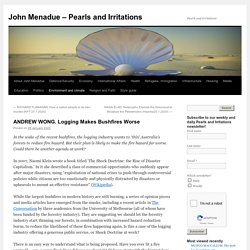
But their plan is likely to make the fire hazard far worse. Could there be another agenda at work? In 2007, Naomi Klein wrote a book titled ‘The Shock Doctrine: the Rise of Disaster Capitalism.’ In it she described a class of commercial opportunists who suddenly appear after major disasters, using “exploitation of national crises to push through controversial policies while citizens are too emotionally and physically distracted by disasters or upheavals to mount an effective resistance” (Wikipedia).
While the largest bushfires in modern history are still burning, a series of opinion pieces and media articles have emerged from the smoke, including a recent article in The Conversation by three academics from the University of Melbourne (all of whom have been funded by the forestry industry). There is an easy way to understand what is being proposed. Related. Frequent fire makes the bush more likely to burn, UOW study finds.
News, latest-news, As firefighters prepare for an earlier than normal bush fire season, hazard reduction burns have again become a fixture in the Illawarra.
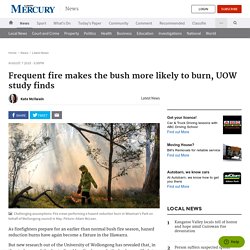
But new research out of the University of Wollongong has revealed that, in the study area of the Australian Alps, fire has made the bush more likely to burn. And while Dr Philip Zylstra says his findings don’t mean hazard reduction burns should be stopped, he says it does challenge “the central assumptions in Australian fire management”. He calls these ever-present burns “prescribed burning” as “it’s only hazard reduction if it does reduce the hazards”. Read more: Hazard reduction burns shroud the Illawarra with smoky haze “Traditionally, people think ‘oh, that forest hasn’t burnt for a long time, so it’s flammable’,” he said. As firefighters prepare for an earlier than normal bush fire season, hazard reduction burns have again become a fixture in the Illawarra. Frequent fire makes the bush more likely to burn, UOW study finds. Indigenous leaders say Australia's bushfire crisis shows approach to land management failing.
Updated 14 Nov 2019, 8:51amThu 14 Nov 2019, 8:51am Indigenous leaders, who have been warning about a bushfire crisis for years, are calling for a radical change to how land is managed as Australia faces some of its worst bushfire conditions on record. Key points: International-security-expert-slams-australia-s-abysmal-fire-strategy-20191121-p53cp2. "Forget that online al-Qaeda study manuals have directed this kind of attack specifically at Australia almost 10 years ago, it's clear to all now how abysmal our fire strategy is," he said.
Prime Minister Scott Morrison this week defended his government's preparation for the bushfire season, saying any suggestion the Coalition's climate change policies were impacting directly on specific fire events "doesn't bear up to credible scientific evidence". The minister for defence has outlined the roles of the defence force in the current bushfire crisis. Humans light 85% of bushfires, and we do virtually nothing to stop it. It’s hard to comprehend why someone would deliberately light a bushfire. Yet this behaviour regularly occurs in Australia and other countries. We would go a long way to preventing bushfires if we better understood this troubling phenomenon. Fire Analysis Module for Ecological values (FAME) How ecological values were considered in past fire management decisionspotential indicators to estimate the impact of planned fire and bushfire on plants and animalswhat existing ecological data, models and risk assessment tools were suitable to includeinformation gaps in how plants and animals respond to fire We packed up all the ecological data, models and analysis tools into a web-based browser called the Fire Analysis Module for Ecological values (FAME).
It allows users to evaluate the impact of different fire management strategies on ecological objectives, and automates documentation of (i) data inputs, (ii) key decision points undertaken as part of the analyses and (iii) standard outputs. For example, FAME can show how the relative abundance of a species changes in response to fire in the landscape over time and space. A surprising answer to a hot question: controlled burns often fail to slow a bushfire. As sure as night follows day, this week’s bushfires prompted inevitable debate about whether fire authorities should have carried out more hazard reduction burning, and whether opposition from conservationists prevented this. There are two key points to remember when we consider these questions. First, the impact on human life and property - not the impact on the environment - is the number one concern in the minds of fire officials when deciding whether to conduct a controlled burn. Second, and perhaps more importantly, evidence shows increasing the frequency or area of controlled burns does not necessarily reduce the bushfire risk.
Victorias Bushfire History 1802 to Present. A surprising answer to a hot question: controlled burns often fail to slow a bushfire. Victorias Bushfire History 1802 to Present. Burn-offs have almost no effect on bushfire risks, Tasmania study finds. New modelling on bushfires shows how they really burn through an area. Bushfires in Australia can have a devastating impact on an environment and destroy homes and lives, so any effort to prevent them is a welcome move.
Prescribed Burning Conference 2019. Sustainable land management key to reducing Amazon wildfires, study shows. Sustainable land management key to reducing Amazon wildfires, study shows The unrelenting deforestation of the Amazon region could lead to a dramatic increase to the risk of destructive wildfire outbreaks, research has shown. The new study suggests that unrestrained deforestation, converting rainforest to agricultural land, could expand the areas at risk of wildfires by more than 70 per cent by the end of the century. Biodiversity highest on Indigenous-managed lands. More than one million plant and animal species worldwide are facing extinction, according to a recent United Nations report. The loss of biodiversity comes at a price. The loss of biodiversity comes at a price. How have wildfires affected Utah Lake? Researchers are looking into it. PROVO — Researchers are trying to understand how ash from last summer’s Pole Creek, Bald Mountain and Coal Hollow fires are affecting Utah County's watersheds.
BYU researchers studying exactly how last year's fires affected the ecosystem. Effects of climate and land‐use change scenarios on fire probability during the 21st century in the Brazilian Amazon - Fonseca - 2019 - Global Change Biology. The joint and relative effects of future land‐use and climate change on fire occurrence in the Amazon, as well its seasonal variation, are still poorly understood, despite its recognized importance. Using the maximum entropy method (MaxEnt), we combined regional land‐use projections and climatic data from the CMIP5 multimodel ensemble to investigate the monthly probability of fire occurrence in the mid (2041–2070) and late (2071–2100) 21st century in the Brazilian Amazon.
Charred forests not growing back as expected in Pacific Northwest, researchers say. Hotspots Fire Project. Keene and DellaSala: Lane County’s forests being whittled down - Opinion - The Register-Guard - Eugene, OR. Severe fire weather and intensive forest management increase fire severity in a multi-ownership landscape. - PubMed - NCBI. Revealed: air pollution may be damaging 'every organ in the body' Logging makes forests more flammable: study (Catalyst, ABC TV Science) Floods and Storms After Fires Guide. Air pollution reduces rainfall - The Science Show - ABC Radio National (Australian Broadcasting Corporation) Water Quality Bushfires and water quality.
Forest soil needs decades or centuries to recover from fires and logging. Tenterfield fires trigger demand for new management approach. The impact of savanna fires on Africa's rainfall patterns. Effectiveness of forest residue mulching in reducing post-fire runoff and erosion in a pine and a eucalypt plantation in north-central Portugal. Fire science for rainforests. Effects of fire and torrential rainfall on erosion in a Mediterranean gorse community - De Luis - 2003 - Land Degradation & Development.
Effects of controlled fire on hydrology and erosion under simulated rainfall. Interactions between rainfall, deforestation and fires during recent years in the Brazilian Amazonia. Statewide Victoria. Study Finds a Connection Between Wildfires and Drought. The impact of savanna fires on Africa's rainfall patterns. There is no single solution to the tragedy of escaped fires. Air quality in the Latrobe Valley unhealthy again - Environmental Justice Australia. South East Queensland Fire and Biodiversity Consortium - SEQFBC. Exposure to air pollution before and after birth may affect fundamental cognitive abilities. Air pollution boosts lung, heart risks › News in Science (ABC Science) Hotspots Fire Project.
Revealed: air pollution may be damaging 'every organ in the body' Sydney smoke haze: bushfire reduction burns suspended to allow air to clear. Health warning as smoke haze blankets Sydney. Black Saturday - Forests after the fires - Victorian National Parks AssociationVictorian National Parks Association. Black Saturday - How things have changed - Victorian National Parks AssociationVictorian National Parks Association. Black Saturday - Ten years on - Victorian National Parks AssociationVictorian National Parks Association. Victoria bushfires: fuel reduction burns would not have saved homes, says minister. Katherine Wilson. Logging burns conceal industrial pollution in the name of 'community safety' Wet forest logging linked to Black Saturday fire severity. Researchers Uncover Just How Damaging Fires and Logging Are to Forest Soil. Scratching lyrebirds create forest firebreaks › News in Science (ABC Science)
Contrary to common belief, some forests get more fire-resistant with age. Forgotten fauna: Habitat attributes of long-unburnt open forests and woodlands dictate a rethink of fire management theory and practice. It's time to stop lighting fires - Tasmanian Times. International Journal of Wildland Fire. Low-severity wildfires impact soils more than previously believed: Negative effects of low-severity fire on soil structure and organic matter. Forgotten fauna: Habitat attributes of long-unburnt open forests and woodlands dictate a rethink of fire management theory and practice.
Victoria's logged landscapes are at increased risk of bushfire. This scary NASA map shows how the world’s forests are going up in smoke. How forests carry out their own fire suppression management. It’s time to stop lighting fires. Fire in the Australian Landscape. Burn-offs have almost no effect on bushfire risks, Tasmania study finds. Tathra losses unlikely to have been worsened by lack of planned burns. Is Fuel Reduction Burning the Answer? – Parliament of Australia.
Video lecture: Did Australian Aboriginals burn the bush as we are told? Joel Wright, "The language of fire." Burnoff policies could be damaging habitats for 100 years. There’s an urge to fuel reduction burn, but not to learn. DEPI - Planned burns. Percentage targets for planned burning are blunt tools that don’t work. Firebook Accessibility final. Association for Fire Ecology - Home.
Environmental Protection Information Center (EPIC) » Fire as an Excuse for Logging. McArthur Mk 5 Forest Fire Danger Meter. Effects of logging on fire regimes in moist forests. AUSTRALIA’S BIODIVERSITY – RESPONSES TO FIRE. Theconversation. The effects of fire regimes and logging on forest stand structure. Logging and Fire in Australian Forests: errors by Attiwill et al. (2014) - Bradstock - 2014 - Conservation Letters.